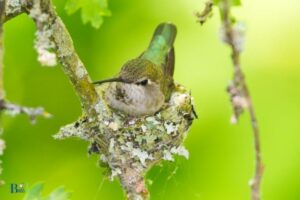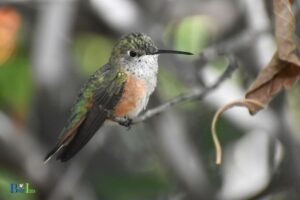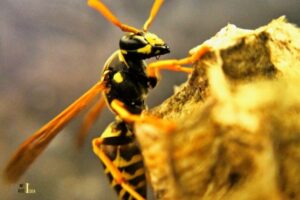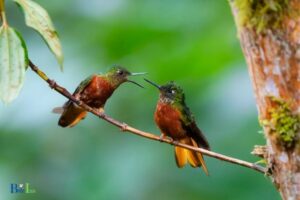How Do Hummingbirds Get Protein? From Insects, Arachnids
Hummingbirds get protein primarily from consuming insects and spiders, which supplement their diet of nectar and sugar water.
Although hummingbirds are known for their love of nectar and sugar water, these sources provide them with carbohydrates for energy but do not supply the necessary proteins that make up a significant part of their diet.
To meet their protein needs, hummingbirds consume small insects and spiders, which also provide them with essential fats, vitamins, and minerals.
In order to obtain sufficient protein, hummingbirds actively hunt for insects and spiders in various ways.
Some methods include catching insects mid-air, picking them off leaves or branches, and even consuming insects trapped in spiderwebs.
This diverse diet helps hummingbirds maintain their high metabolic rate and support their rapid wing movement, which allows them to hover and fly at incredible speeds.
6 Protein Source Of Hummingbirds
| Source of Protein | Description | Example |
|---|---|---|
| Insects | Hummingbirds eat small insects as a source of protein. | Aphids, mosquitoes, gnats, fruit flies, and ants. |
| Arachnids | These small birds also consume spiders and their eggs. | Small spiders like jumping spiders, and spider eggs. |
| Insect larvae | Hummingbirds can snatch insect larvae from trees and plants. | Caterpillars, fly larvae, and beetle larvae. |
| Nectar | Nectar provides some essential amino acids, but not enough. | Flower nectar from various plants, like salvia or fuchsia. |
| Pollen | Accidentally ingesting pollen provides a small protein boost. | Pollen from various flowers while drinking nectar. |
| Insectivorous plants | Insects trapped on these plants may also attract hummingbirds. | Insects stuck on sticky traps of carnivorous plants, like sundews or pitcher plants. |
Key Takeaway
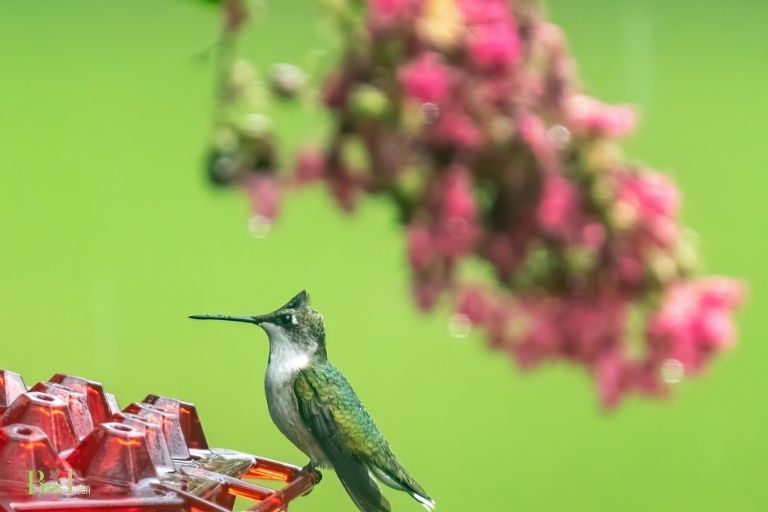
Five Interesting Facts About Hummingbird Nutrition
What Are Hummingbirds?
Hummingbirds are a tiny yet fascinating family of birds that are known for their exceptional flight ability. These birds belong to the trochilidae family and are native to the americas.
There are over 300 species of hummingbirds, with most of them living in south america. They are also a common sight in north america, especially in the west.
Description Of Hummingbirds
Hummingbirds are remarkable birds that are known for their small size and unique physical characteristics.
Here are some key features of hummingbirds:
- Size: Hummingbirds are small birds that measure between 2.75 to 8 inches in length and weigh between 2 to 20 grams.
- Color: Hummingbirds’ feathers come in a range of colors, including green, blue, red, and purple. Some species have metallic feathers that shine in the light.
- Bill: Hummingbirds have long beaks that are used for extracting nectar from flowers. During feeding, their tongues can extend up to twice the length of their bills.
- Wings: Hummingbirds have the ability to flap their wings rapidly, up to 80 times per second, allowing them to hover in the air.
- Metabolism: Hummingbirds have one of the highest metabolic rates among all animals. This allows them to fly at high speeds and maintain their body temperature.
Unique Characteristics Of Hummingbirds
Apart from their physical features, hummingbirds have some unique qualities that set them apart from other birds.
These include:
- Feeding: Hummingbirds feed on nectar, which provides them with the necessary carbohydrates to support their flight. They also feed on insects, which provide them with protein, essential amino acids, and other nutrients.
- Migration: Hummingbirds are known for their migratory behavior. Some species travel thousands of miles each year from their breeding grounds to their wintering sites.
- Aggression: Despite their small size, hummingbirds can be aggressive towards each other, especially during the breeding season. Males will defend their territory by chasing away other males and attacking other birds that get too close.
- Courtship: Male hummingbirds perform elaborate aerial displays to attract female mates. They will hover in the air and fly in patterns that showcase their physical abilities.
- Sleep: Hummingbirds have a unique sleeping habit where they enter a state of torpor to conserve energy. During torpor, their metabolic rate slows down significantly, allowing them to save energy.
Hummingbirds are fascinating birds that have unique physical characteristics and behaviors. Despite their small size, they are strong and capable flyers that exhibit remarkable behaviors such as migration, courtship, and aggression.
By feeding on nectar and insects, hummingbirds are able to maintain their highly active lifestyle and thrive in their natural habitats.
The Importance Of Protein In A Hummingbird’S Diet
Hummingbirds are fascinating creatures known for their rapid wing beats, hovering capabilities, and their need for nectar as a primary source of energy.
However, nectar alone is not sufficient to sustain their high metabolic rate, and they need protein to fulfill their dietary requirements.
Protein is a vital nutrient that plays an essential role in various physical processes necessary for hummingbirds’ survival.
In this blog post, we will discuss the significance of protein in hummingbirds’ diet and the consequences of protein deficiency.
Explanation Of The Role Of Protein In A Hummingbird’S Diet
Protein is essential for hummingbirds, and it plays a crucial role in the following:
- Growth and development of muscles, tissues, and organs
- Maintenance of feathers, beaks, and claws
- Production of enzymes and hormones
- Transport of oxygen and nutrients throughout the body
- Repair and regulation of cellular damage
Hummingbirds obtain protein through their diet consisting of insects, spiders, and sometimes, small vertebrates and pollen.
The protein content in these food sources supplements their nectar-based diet, maintaining a healthy balance of essential nutrients.
Consequences Of Protein Deficiency In Hummingbirds
Protein deficiency can impact hummingbirds in various ways, affecting their physical and physiological characteristics.
Here are some of the possible effects of protein deficiency:
- Impaired growth and development, affecting overall body mass and survival rates.
- Degradation of feather quality and a reduction in the number of feathers, impacting their flying capabilities.
- Damage to beaks and claws, reducing their hunting efficiency and affecting their foraging abilities.
- Reduced metabolic rate, resulting in reduced energy utilization, leading to slower movements, reduced foraging capabilities, and a shorter lifespan.
- Weakened immune system, leading to increased susceptibility to infections and diseases.
Protein is an essential nutrient in the diet of hummingbirds, vital for their growth, development, and overall well-being.
To ensure their survival, it is crucial to provide a balanced diet rich in both nectar and protein sources.
As bird enthusiasts, we must take the necessary steps to protect their habitats, ensuring that they have sufficient available food sources to support their dietary requirements.
Sources Of Protein For Hummingbirds
Hummingbirds are fascinating creatures known for their incredible flying skills and striking colors. But have you ever wondered how these tiny birds obtain protein?
In this section, we will discuss the natural sources of protein for hummingbirds and how they extract this vital nutrient from their diet.
Natural Sources Of Protein For Hummingbirds
Hummingbirds primarily obtain their protein from insects, spiders, and other arthropods. They are also known to feed on nectar and pollen, which contain small amounts of protein.
Some of the common sources of protein for hummingbirds are:
- Insects: Hummingbirds feed on various types of insects such as gnats, fruit flies, mosquitoes, and spiders. They catch their prey while on the wing by using their long and slender beaks and tongues with incredible precision.
- Spiders: While spiders may not be a significant source of food for hummingbirds, they do consume them occasionally. Like insects, hummingbirds catch spiders while in flight.
- Nectar and pollen: Although hummingbirds primarily consume nectar for energy, some types of nectar contain protein. Pollen, on the other hand, contains high levels of protein, which can be a valuable source of nutrients.
How Hummingbirds Obtain Their Protein From These Sources
Hummingbirds consume insects and spiders in a variety of ways. They use their long beaks and tongues to probe flowers and capture small insects on the wing.
Once they have captured their prey, they use their beaks to crush, tear, and swallow the insects whole.
When it comes to consuming nectar and pollen, hummingbirds use their long tongues to extract the liquid or granules from flowers.
Unlike their beaks, hummingbird tongues are thin and flexible and can extend up to twice the length of their beaks.
This ability allows them to reach deep into flowers to access the nectar and pollen, which they consume for energy and protein. Hummingbirds rely on a diet of insects, spiders, nectar, and pollen to obtain protein and other vital nutrients.
Their unique adaptations, such as their long beaks and tongues, allow them to extract protein from these sources with incredible precision.
By understanding how hummingbirds get protein, we can appreciate the importance of this nutrient in their diet and the role that it plays in their survival.
How Do Hummingbirds Digest Protein?
Hummingbirds are a unique species of birds that have a specialized diet as they solely feed on nectar and insects. As they consume a plant-based diet, their main source of protein comes from insects.
So, how do hummingbirds digest protein? We will delve into the process of digesting protein in hummingbirds and the specialized digestive system they possess to do so.
The Process Of Digesting Protein In Hummingbirds
Digesting proteins is an essential process for all animals, and hummingbirds are no exception. However, hummingbirds have a specialized digestive system that enables them to process protein-rich diets.
Here are a few key points on how hummingbirds digest protein in their diet:
- Hummingbirds possess a two-part digestive system with a crop and a gizzard.
- The crop stores food, and the gizzard grinds the food into smaller, more manageable pieces.
- Once the food is ground up, it moves into the intestines, where digestive enzymes break down the food’s proteins.
- These enzymes are present in the intestine, pancreas, and salivary glands, enabling hummingbirds to break down the protein-rich insect diet.
Explanation Of The Specialized Digestive System Of Hummingbirds
Hummingbirds have a specialized digestive system that sets them apart from other birds. The two-part digestive system aims to break down protein-rich diets to fulfill the hummingbirds’ nutritional requirements.
Here are a few key points that explain the specialized digestive system of hummingbirds:
- The tiny size of hummingbirds means that they can only eat small amounts of food at any one time. Therefore, the crop stores food near the stomach until it’s ready for the digestive process.
- The gizzard muscles are stronger in hummingbirds to break down the hard exoskeleton of insects. This is to make it possible to grind the food into smaller and more manageable pieces before it is passed on to the intestines.
- Hummingbirds have a speedy metabolism, which means they digest food quickly. This is to make sure they can consume the maximum amount of food in a short amount of time.
Hummingbirds have a unique digestive system that adapts to their protein-rich diet.
Their diet, which is mainly comprised of insects and nectar, requires specialized digestive enzymes to break down proteins and fulfill their nutritional requirements.
FAQ About Hummingbird Nutrition
How Do Hummingbirds Get Protein?
How Much Protein Do Hummingbirds Need?
Can Hummingbirds Survive On Nectar Alone?
How Do Hummingbirds Catch Insects?
What Happens If Hummingbirds Don’t Get Enough Protein?
Conclusion
Hummingbirds are complex creatures in their feeding and nutritional requirements. They have a unique way of significantly extracting protein by consuming insects and spiders, as well as nectar from flowers.
Despite their small size, they have a high metabolic rate and require high quantities of protein to sustain their active lifestyle. They have adapted to their environment by exploiting the available food sources, including visiting different flowers to obtain nectar and insects.
However, the protein needs of hummingbirds may be challenged in areas with limited insect availability and changes in vegetation. It is essential to continue investigating the nutritional requirements and feeding habits of these captivating birds to develop conservation strategies to protect them.
Overall, hummingbirds have developed unique adaptations to meet their daily nutritional requirements, making them fascinating creatures worth exploring and learning from.


